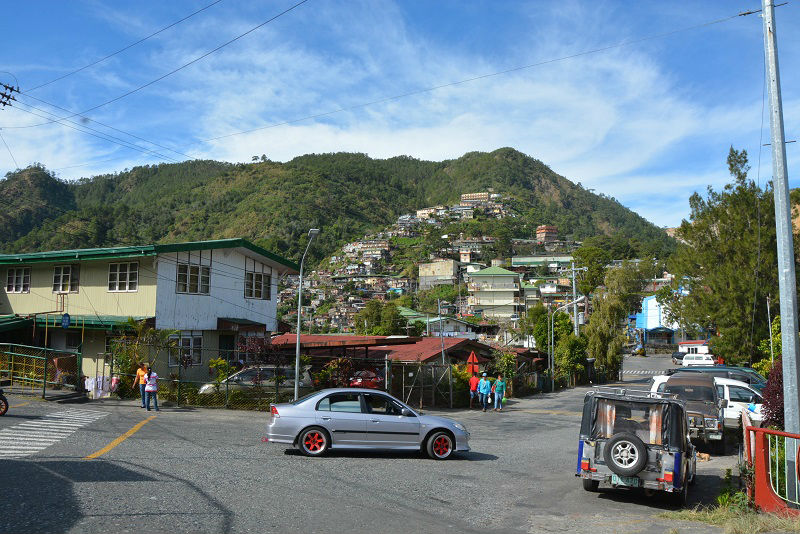OLD MINE TAILINGS POND – Assorted tree plantations within the rehabilitated tailings pond No. 1 of the Philex Mining Corporation at Bangad, Ampucao, Itogon, Benguet. PMC Photo
(This story was funded under the Covering the Extractive Industries: Digging Out the Stories that Matter fellowship program of the Philippine Press Institute in partnership with the Philippine Extractive Industries and Transparency Initiative.)
TUBA, Benguet – The early afternoon rains started to fall right in the midst of the supposed extreme summer heat. Among the indigenous peoples of the uplands of Tuba and Itogon, Ibaloi and Kalanguya, such event foretells of a blessing. Nowadays, their water supply, especially potable water, is fast deteriorating and they believe this phenomenon is due to the operations of the Philex Mining Corporation.
Large-scale mining was embraced by the indigenous communities in these two mineral-rich towns in the late 1950s with the promises it held as a catalyst for robust development to bring them to prosperity with improved economic activities, sustainable sources of livelihood and accessible social services. Nowadays though, they ask themselves if they brought their own maldevelopment. The benefits which they thought would bring them better lives have instead resulted to conflicts among themselves. The benefits brought out the greed in their persons with some wanting to have more than the others, apart from their eroding water supply over the past three years which has caused them to raise issues on whether they will be guaranteed sustainable sources of water beyond mine life which was fixed by Philex Mining Corporation to be by the end of 2022.
https://www.youtube.com/watch?v=gxgqQteNAT4&feature=youtu.be
Itogon is situated in the southeastern part of Baguio City while Tuba is in the southwest. Both towns are first-class municipalities primarily due to their income from mining. Barangays Camp 3 in Tuba and Ampucao in Itogon are the mining companies’ host communities while the villages of Camp 1 and Ansagan in Tuba and Dalupirip in Itogon are classified as outlying communities which also benefit from the operation of the company in terms of various infrastructure, health, education and livelihood projects. Aside from agriculture, the major source of livelihood of the people, composed of around 98 percent indigenous peoples, is small-scale mining and almost 60 percent of the people in the said places are either self-employed or have other jobs outside of their barangays.
“Life was somewhat good before and in the early days of mining, although we had to hike for around four hours to market our produce along Kennon road or in Philex and another four hours going back home,” 52-year old Asia Gabino recalls as she looks out of the window of the barangay’s multipurpose hall with a smile on her face. They did not have to fetch water from distant sources for their cabbages, beans, potatoes and other high value vegetables, to survive the summer heat. “However, the building of barangay, municipal, provincial and national roads leading to our villages made life easier because most of us were able to own private and public motor vehicles that helped us transport our goods,” she added.
“Today, we have to work extra hard to earn a decent income to sustain our present living condition similar to what our parents have been doing in the past although work could be done easier now because of the existence of machines that aid us in our work,” she stated, saying that the number of people considered to be poor had dropped through the years. Based on the data obtained from the Cordillera office of the Philippine Statistics Authority (PSA-CAR), the poverty incidence in Tuba in 2006 was said to be at 6.4 percent before it increased to 14.2 percent in 2009 but drastically dropped to 4.5 percent in 2012. In Itogon, the poverty incidence was pegged at 5.8 percent in 2006 before slightly increasing to 8.9 percent in 2009 bt also drastically dropped to 4.8 percent in 2012. Results of the PSA-CAR small area poverty incidence are expected to be released to the public by next month.

Philex was incorporated sometime in 1955 but its operations as a large-scale mining company started in 1958. It acquired a tenement area of over 14,000 hectares covering the host and outlying communities, but only 5 percent has been utilized for the mine camp and its facilities. From 2013 to 2017, Philex produced an average of 100,000 ounces of gold and over 32 million pounds of copper with an annual average net income of over P800 million.
In the early 1900s up to the early 1990s, Benguet played host to the operation of 4 large-scale mining operations, particularly the Benguet Corporation which operated in Itogon from 1903 up to 1993, the Itogon-Suyoc Mins Inc. also in Itogon, the Lepanto Consolidated Mining Corporation in Mankayan and Philex Mining Corporation in Tuba. Currenly, only Lepanto and Philex are in operation while BC is currently operating its mine tenement through its Acupan Contract Mining Project with the small-scale miners and Itogon-Suyoc Resources Corporation in Itogon has just started reviving operations.
Gabino explained that based on their forefathers stories, the consent of their peoples was secured through the traditional ‘tongtongan’ where company officials directly negotiated with the Ibaloi and Kalanguya elders for the opening of the mines. Then, there were no laws on mining and indigenous peoples rights requiring their free prior and informed consent before any development can done in their communities but this indigenous consensus decision-making system has been practiced since time in memorial.
Under the ‘tongtongan’ system, elders are gathered to deliberate to settle conflicts or decide on matters affecting the community, for instance, the implementation of a project. What prevails is the consensus reached among them after thorough discussions which may take days. Then, there was no documentation of the proceedings, but the word of mouth was sacred and the trust on and respect to the elders by their constituents was very much observed. This is how the communities became engaged with the mines.
“Our parents often tell us it was easy to request for any form of assistance from the mine management as even verbal requests were immediately granted by the management with the needed cash,” Gabino claims. “Since the enactment of the Philippine Mining Act, the Indigenous Peoples Rights Act and other related laws, rules and regulations, projects to be funded by the company must pass through a stringent process defined by law and many elders are disappointed because they no longer enjoy the cash assistance,” she said.
The Mining Act of 1995 specifies that the Social Development and Management Program (SDMP) is a mandatory appropriation in the annual budget of a mining company to help in the socio-economic development of the directly and indirectly-affected areas and make the communities resilient even after mine life. Initially, the prescribed allocation was 90 percent of 1 percent of the company’s mining and milling cost but this was increased to 1 percent of the company’s direct operating cost and eventually, to date, 1.5 percent of the company’s direct operating cost.
Under the authorized allocation of the SDMP, 75 percent of the fund is for development projects identified by the communities primarily for health, education, livelihood and infrastructure, 15 percent is for the development of mining technology and geosciences while 10 percent is for information and education campaign.
“We agree that Philex’s SDMP projects contributed in the significant development of its host and outlying communities for decades now, however, we in the communities are not yet ready for the projected mine closure in 2022. Most of us rely on the company for assistance, especially in health, education and livelihood. We have not been empowered,” 52-year old Remy Dum-ao, a resident of Camp 1, laments, adding that management and the concerned government agencies must strategize with them projects that have impact on their lives beyond mine life.
She claims there is no actual and sincere planning in the identification of SDMP projects as the company has its list of priorities and the communities have also their list of priorities, thus, what had been happening during the consultations is actually confrontational until they are constrained to agree on certain issues even if it not acceptable to the communities.
“We agree there were some lapses in the preparation of the 5-year and annual SDMP plans in the past but for the last 5-year SDMP plan of the company for 2018-2022, we made sure that all the priority concerns of the host and outlying communities were included through the planning and consultation stages done over the past several months. We can conclude we addressed the major concerns of the communities in this last 5-year SDMP plan,” Aurora Dulipas, Philex community relations manager, stated.
A concrete example of the so-called wrong priorities in the utilization of SDMP funds, Dum-ao explained, was the purchase of the P70 million state-of-the-art mine simulator by the previous management in 2015. This is being used by the mine for their training among other mine-related activities but the funds could have been used for other productive projects in the communities. But Dulipas quickly explained that the mine simulator was purchased through the information and education component of the SDMP and it is now being used to train newly hired load-haul and dump (LHD) operators and retrain old ones, especially when their units of equipment get easily destroyed, considering the expensive cost of the parts of the equipment used underground.
Further, Dum-ao, who has a background in community organizing, also points out the other ‘white elephant’ built through SDMP funds is a 2-storey barangay health center inside the compound of the Ligay Elementary School which was not coordinated with the Department of Education. This created conflicts between the agencies, the barangay and the company which has yet to be settled to date. “We initially proposed that the constructed barangay health center be registered as a school clinic with the education department since it was constructed within the school property but it will still be used by both the school and the barangay for the various immunization programs to maximize its use, but we do not understand why the barangay and the company refuse to agree to such arrangement,” Dum-ao emphasized.
In terms of the infrastructure projects funded from the SDMP fund, she recommended the total scrapping of the ‘batog-batog system’ so that all projects will be awarded to and implemented by licensed contractors from the communities with the assistance of the company to guarantee good quality of projects and rid conflicts among residents in the prioritization of projects.
“Batog-batog’ is a local term for ‘adjacent’ and it refers to the practice in these communities here that once a project affects or traverses a property of a land owner, the owner will be the one to implement the said project. Dum-ao has observed that the ‘batog-batog’ system has become a source of conflicts among family and clan members because there are enterprising individuals who insist that they should have a bigger share in the funds even if their properties are smaller than or the same area as their neighbors.
By: DEXTER SEE















